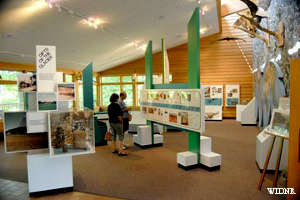Interstate State Park

The Dalles of the St. Croix River

Inside the Ice Age Interpretive Center
Interstate State Park is a 1,330-acre property located on the St. Croix River, immediately across from Minnesota's Interstate State Park. Both parks are within the bounds of the St. Croix National Scenic Riverway and essentially straddle the river in that region known as the Dalles of the St. Croix River. The Wisconsin state park is one of the nine sites included in the Ice Age National Scientific Reserve and the park serves as the western terminus of the Ice Age National Scenic Trail. Interstate State Park is Wisconsin's first state park, established in 1900 to help protect the basalt of the Dalles area from being quarried for gravel.
About 1.1 billion years ago, a series of volcanic eruptions spewed lava across the mid-continent of (what is now) North America at least ten times. That lava hardened and formed a thick layer of basalt that was later over-burdened with sandstone and siltstone when that basaltic surface went underwater during the Cambrian period. Much of that softer surface material was scraped off during the great periods of glaciation between 110,000 years ago and 10,000 years ago, exposing areas of the underlying basalt again. As the glaciers retreated about 10,000 years ago, the meltwaters were of such volume as to carve out the St. Croix Valley in a short time. The flow was able to erode wide valleys above the basalt but upon reaching that harder rock, were forced to follow cracks and low spots in the rock to continue their journey to the Gulf of Mexico. Fortunately for that flowing water, a deep joint in the layers of basalt was nearby and that eroded into the narrow, steep-walled gorge known today as the Dalles of the St. Croix River. In most areas where the river flows past Interstate State Park, those walls rise between 50 and 250 feet above the water surface. Glacial waters flowing through carried varying amounts of rock, sand and silt. Near those ancient river banks, that sand and gravel often got caught in eddies and whirlpools that swirled with such speed and ferocity that they ground holes straight down into the rock. The Glacial Gardens area in the Minnesota park has the greatest concentration of these glacial potholes on Earth: more than 80 of them. One of them, the Bottomless Pit, was excavated and found to be 10 feet wide and 60 feet deep. Other unexcavated potholes in the area are wider, suggesting they may be deeper, too.
From 1837 to 1898, the St. Croix River was a major route for rafts of logs to follow as they made their way out of the forests and traveled south toward the sawmills. Several times over the years severe logjams formed along the river, the worst being the logjam of June, 1886. During the six weeks it took 175 men working night and day to break up that logjam, several of the mills waiting for timber downstream went out of business. As the big logjams occurred during years of very low water flow, the Neevers Dam was built upstream in 1890 to regulate water flows on the river. Those logjams also had the effect of attracting hordes of tourists and the St. Croix Falls area became well-known for the beauty and variety of its landscape.
It was a plan formulated by a group of Minnesota businessmen in the 1860's that led to the creation of the two state parks. That was a plan to quarry the basalt along the river and crush it for use as paving and construction gravel. People who knew and loved the area began lobbying their governmental representatives and raising awareness among their neighbors. It worked well enough to stop the plans to make gravel until the Minnesota State Legislature created the Minnesota side of Interstate State Park in 1895. The Wisconsin Legislature didn't pass a bill to create the Wisconsin version until 1900.
Many of the buildings still in use at Interstate State Park were built by Civilian Conservation Corps and Works Progress Administration crews during the 1930's. The architectural emphasis back then was on what's now known as "National Parks rustic" and most of those constructions in the park are now on the National Register of Historic Places.
Today, the park itself is open year-round from 6 am to 11 pm. The ice Age Interpretive Center and State Park Visitor Center is open daily from 9 am to 4 pm. Visitors to the park need to pay vehicle admission fees but holders of National Parks Passports will have those fees waived. Campground fees are the same, whether you hold a National Parks Passport or not. there are two developed campgrounds at the park offering a total of 82 family campsites. There are also two primitive group campsites that can accommodate a total of 60 people.
Upper left photo courtesy of Wisconsin State Parks